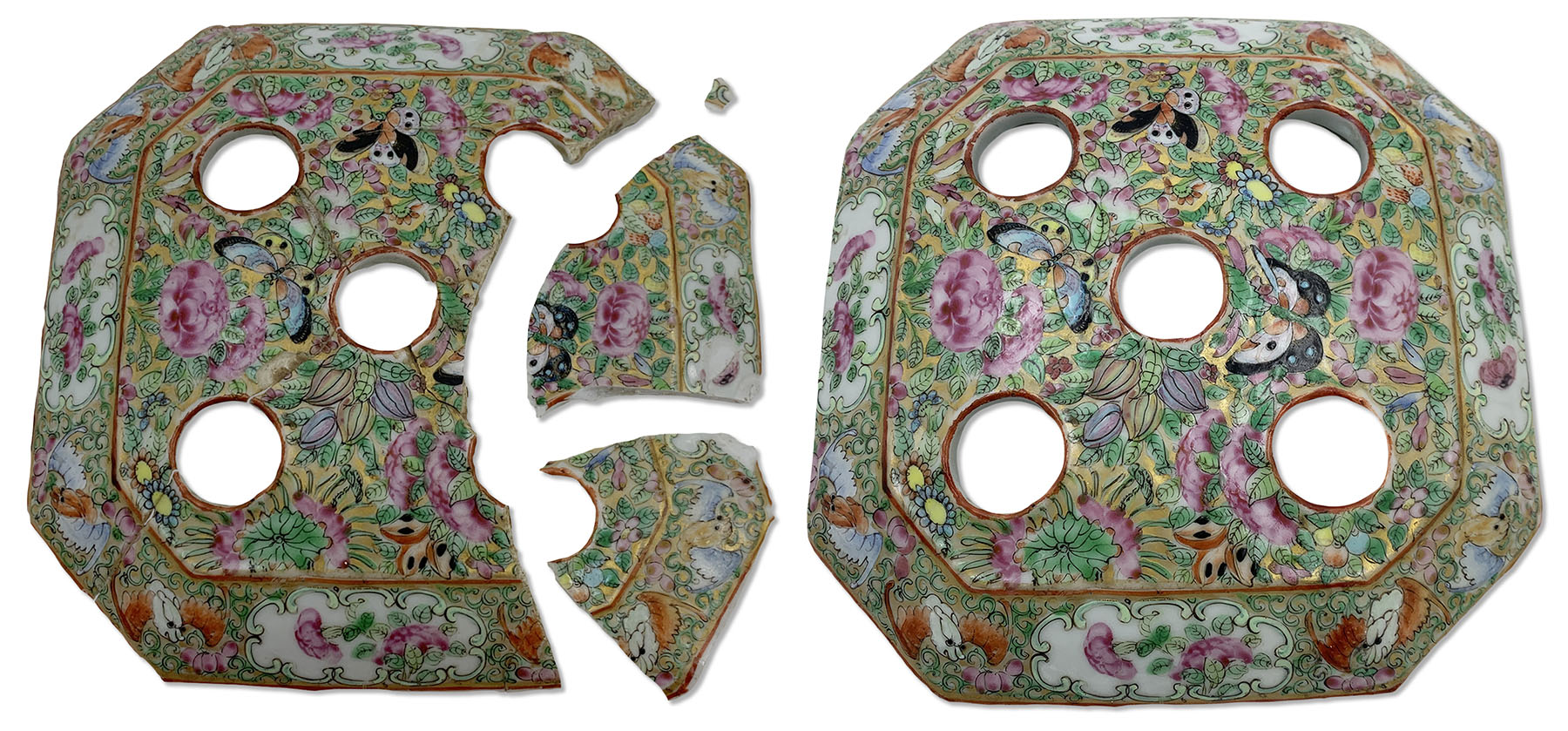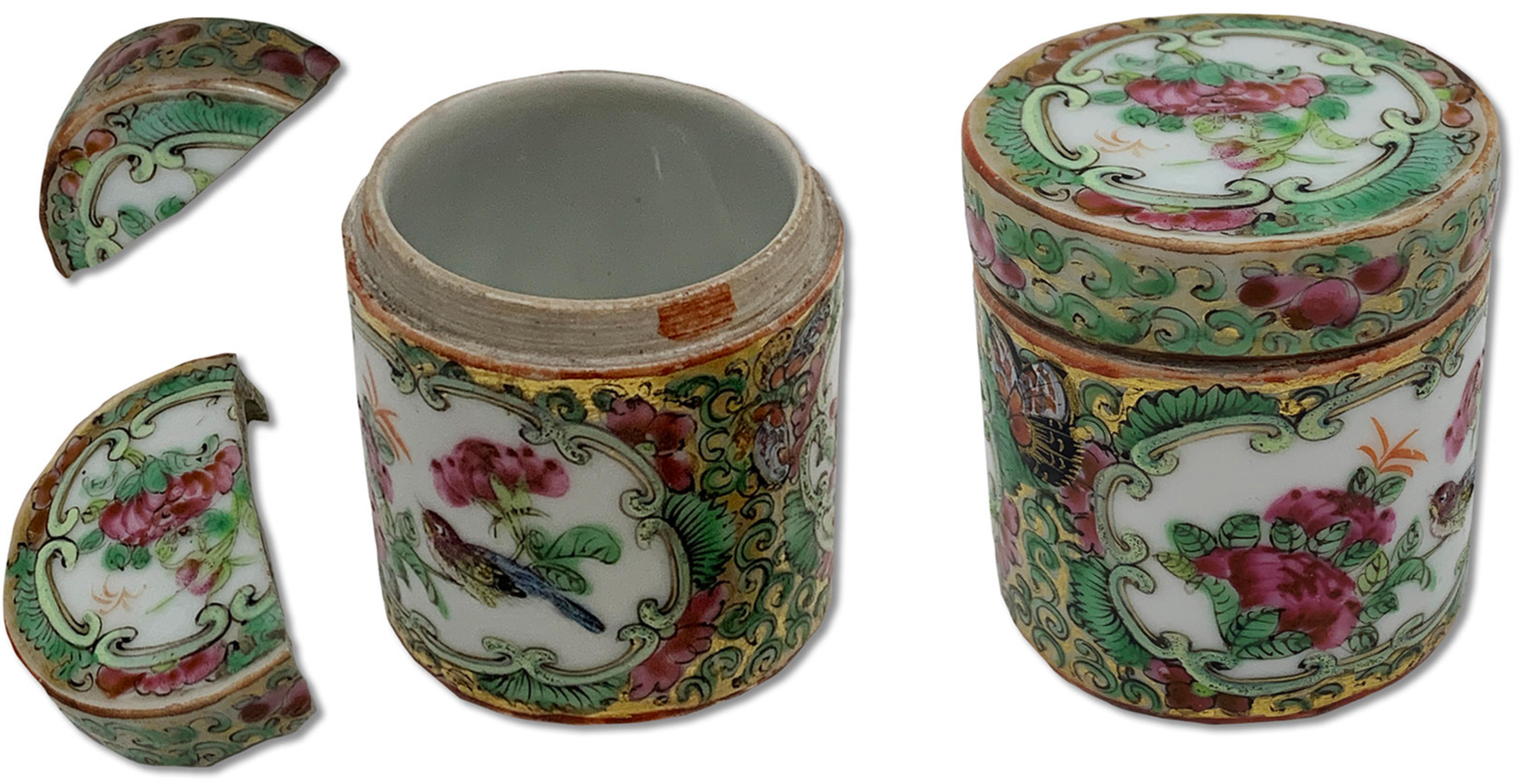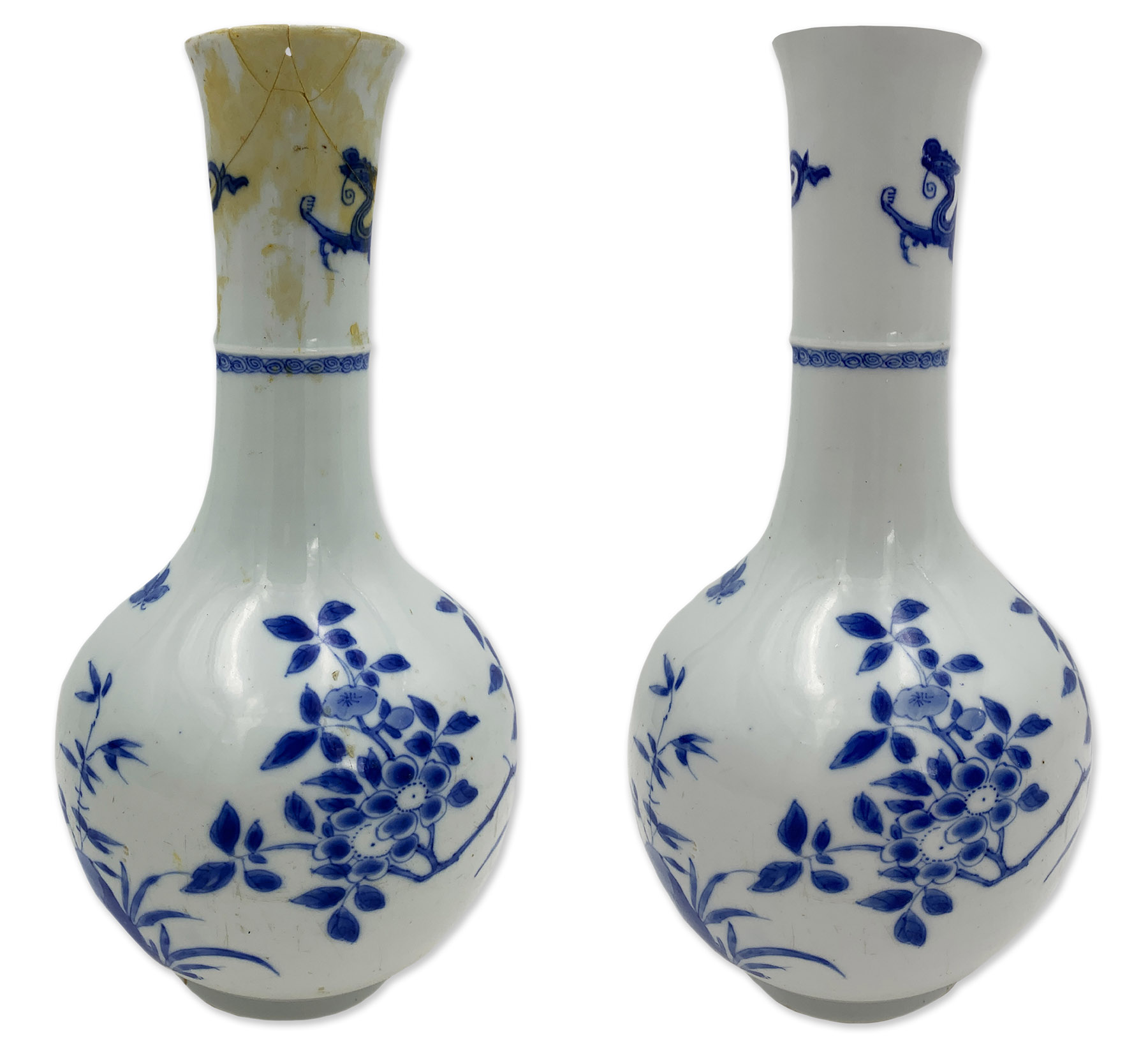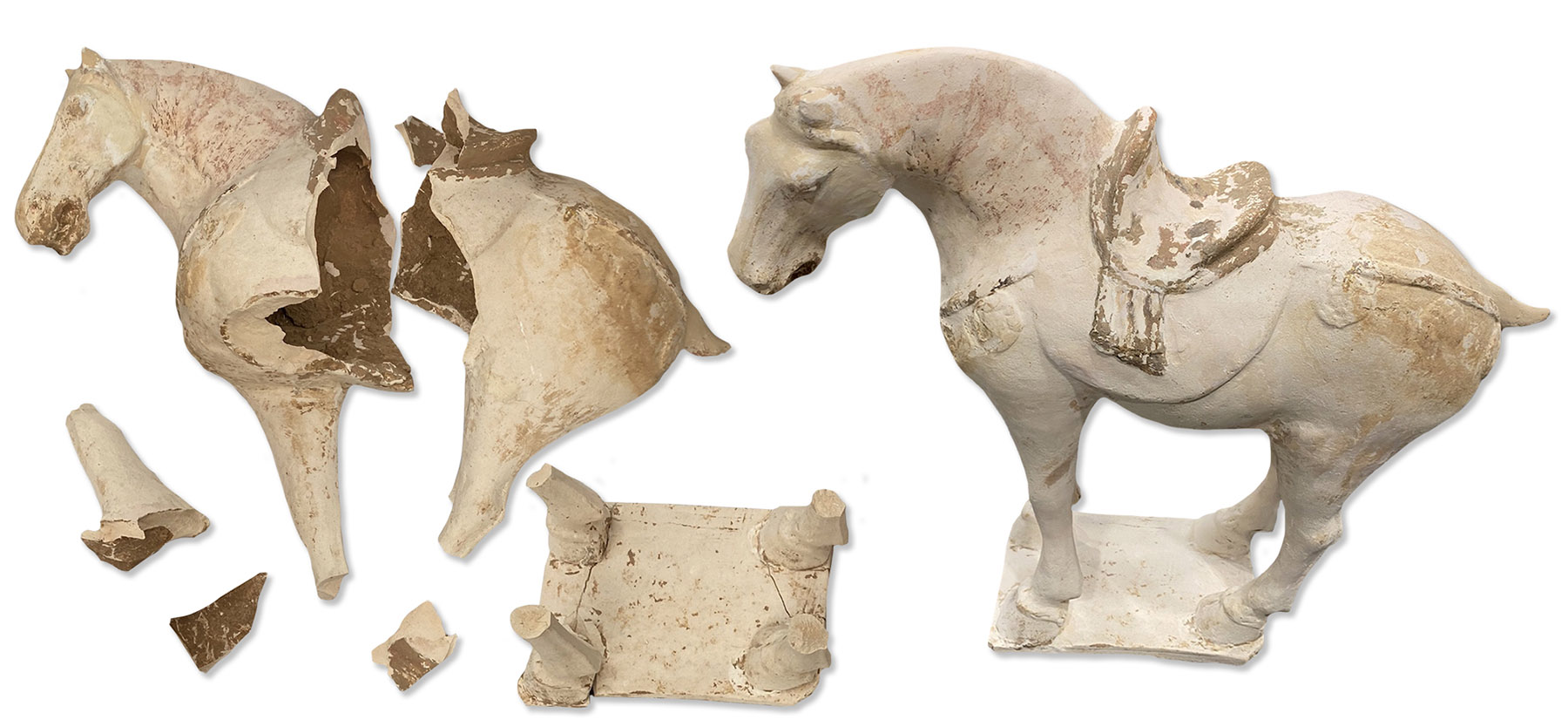Western conservators are rising to the occasion as interest in Chinese art among collectors and investors intensifies both in China and abroad. Wang Yuke reports.

In her compact studio at Somerset House in central London, Amy Walsh — an objects conservator with Fine Art Restoration Co — hunches over a terracotta horse sculpture on the workbench, nursing it with the precision of a seasoned veterinary surgeon. The sculpture, believed to be of Chinese origin, rests delicately as she gingerly works on a minute seam with a needle.
She then proudly shares photos of a Chinese incense holder lid she “cured” months earlier. The octagonal lid rests on a twill tablecloth reminiscent of an operating table, as if lamenting its disintegrated body. However, the artifact’s beauty still prevails, exuding an idyllic serenity, reserved vitality, and a cultured attitude through the meticulous depiction of vivid foliage and pink blossoms, punctuated by butterfly intruders. The dominant palette of green, pink and blue is reminiscent of the garden of the French impressionist Claude Monet.
READ MORE: Museum shines spotlight on cloisonne
As global interest in collecting and investing in Chinese art grows, so does the demand for restoration, as all art inevitably deteriorates over time. This is where Western restorers and conservators like Walsh come into play, preserving the “health” and cultural narrative of these exported Chinese treasures. Their dedication is, to no small extent, fueled by their acute fascination with Chinese art and culture.
Speaking of the dainty Chinese ceramic incense holder from one of her clients, Walsh exclaims: “It’s beautifully made, very delicate. The curio, despite its lack of exact provenance and year, had been executed in a very skilled and controlled manner. But when you get to it very closely, you can still pick out the touch of an artist, the raw texture that’s left behind.”
With Walsh’s professionally trained eye, the seemingly assertively crude traces of brushstrokes, rather than being perceived as blemishes, come alive, injecting character and vitality into the petite antique. Not unlike judging a stranger by their features, wardrobe, articulation, facial expression and body language before striking up a friendly conversation, examining an art object from top to toe, from within and without, and from the visible details to its deeper backstory, is the foundation of all subsequent restoration work.

Walsh handles her trade more from a “craftsperson’s” or surgical perspective. Using a surgical lens is by no means straightforward, involving forensic assessment of the art piece’s raw materials, and clinical diagnostics to gauge the extent of the damage, artistic sensibility to colors and patterns, and the meticulous craftsmanship needed for its restoration.
“When we get a client’s piece, I’ll carefully check its condition and recommend what can be achieved through conservation. It involves thorough photographic and written documentation, cleaning, bonding broken pieces, recreating lost pieces and retouching lost details. Conservation requires a range of practical hand skills drawn from craft practices, balanced with elements of chemistry and ethical considerations,” she says.
Walsh, whose father was a potter, became associated with ceramics in her formative years. Over time, she has developed a deep affinity for it. “As a child, I would visit him at the pottery factory. He always had his wheel and kiln at home as well. I grew up surrounded by ceramics,” she recalls. Among the ceramic fixtures at her home was a blue-and-white bowl gifted to her dad by a Chinese potter when he visited Australia in the 1980s. This was probably Walsh’s first encounter with Chinese art when she was “definitely under 10”. She vividly remembers being captivated by the exquisite patterns on the bowl, which held a place of pride in her father’s cabinet. Her admiration for Chinese ceramics has not only endured into adulthood but also deepened, translating into her affectionate stewardship of these delicate treasures.
Walsh found the demureness and hushed elegance of the incense holder that she was attending to had not remotely diminished because the lid had broken into three jagged pieces. The fracture had left two of the lid’s five holes separated from the rest of the structure, disembodied from its entirety. On the bigger stray fragment was a fluttering butterfly, its wings rimmed in black appearing as fragile as its main body left behind on the relatively intact part of the lid. This would be the most challenging part of her restoration work.
“Although the incense holder is a solid heavy object, the hand-painted butterflies gave it a sense of lightness, rendering the whole piece softer and ladylike,” says Walsh as if mirroring the dulcet-toned nature of her “new friend”. She treats every broken piece of art sent to her for salvage as an acquaintance that gradually becomes close to her.
With ceramics, the restorer cannot simply refill the missing paint with clay or ceramic as the entire object, having been fired in a kiln, cannot endure a second “baptism by fire”. “Instead, we have to employ modern alternatives, like epoxy, adhesives and calcium-based fillers, to imitate the materials used in the ceramic object of historical provenance and significance,” she says.
To compound the onerous work, the cleavage of the incense holder’s lid turned out to have been snappily cobbled together with a wonky “superglue” before it was sent to Fine Art Restoration Co for proper remedy, laments Walsh. Moreover, touching up the butterfly motif to match the original artist’s virtuosic craftsmanship requires tremendous artistic and technical dexterity.
Her restoration of the ceramic lid began with the application of a poultice to remove the superglue and clean up any residue. She then rebonded the ceramic using epoxy adhesive which is renowned for “aging gracefully”. “Next, I used ‘dry’ pigments to fill in the areas that had been lost, imitating the look of both the clay and the glaze. Once everything had been cured, I gingerly sanded and polished only the areas I had restored, taking great care not to offend the original surfaces.”

Mystery of blue
The color theory greatly comes into play in retouching and repainting. The process involves mixes and matches made through experience, gut instinct, and trial and error on a small palette — it’s the only way to solve the Pantone puzzle. As Walsh reflects, blue is perhaps the most enigmatic color. Coincidentally, blue is also one of the most frequently recurring and iconic shades among ancient Chinese artifacts. Consider the sinuous five-clawed dragon, inked in blue, coiling around the neck and body of a teapot from the Ming Dynasty (1368-1644), exuding vigor and power; or the blue cloud scrolls — xiangyun in Chinese — that adorn Chinese art, architecture, furniture and textiles for their auspicious meanings; or the interlocking swirling peony flowers, rendered in cobalt blue, that take pride of place on Chinese porcelain vases, symbolizing health, prosperity and harmony.
“The issue with blue is metamerism which means that blue will look different under different lighting. If you look at a blue object outside in sunlight, there’s a very good chance you’ll see a nuanced blue under artificial lighting indoors. The blue changes,” Walsh explains.
What should a Chinese art restorer aim to achieve? “A blue that fits all environments, indoors and outdoors,” she says, while displaying a rack of paints shaped like drip tubes used in laboratories, each one labeled with its precise name — ultramarine blue, cobalt blue, cerulean blue. “In blue-and-white Chinese ceramics, even within a single object, there can be a dazzling array of shades. It’s more complicated than it seems. You build it up in layers with thin coats of paint before you can try to replicate the tonal variations.”
She then lays four color tubes on the table, as if presenting a verdict on the formula for “traditional Chinese porcelain” — flake white, lemon yellow, raw umber and ultramarine. “You see, Chinese porcelain is never purely white. It always has a very faint greenish blue tint,” says Walsh, revealing her discovery on a porcelain artifact.

Wisdom in art
The pathos of restoration, for Walsh, lies in the fact that it’s not a be-all and end-all fix to a wounded art object. Everything will degrade in time, including art. Restoration is less about providing a one-time panacea for an art object’s immortality, but more about offering a non-defining treatment, leaving room for eternal possibilities of recalibration and reinterpretation.
Walsh’s acceptance that all repairs will eventually decay and that every artwork has a life expectancy, along with her belief that space should be left for future narratives, may reflect a deep, albeit unconscious, influence of Chinese art, culture and ancient philosophy on her practice, as well as that of other Chinese art restorers abroad.
Chinese art and culture have a porous sway beyond borders. To Walsh, her admiration, sensibility and affinity for Chinese aesthetics and craftsmanship have been shaped by family influence and nourished through cultural engagement, stimuli and even accountability as a cultural exchange ambassador, guardian and “moderator”.
A previous project in Australia, maintaining the Dragon Wall in Sydney’s Chinese Garden of Friendship, set her fervor for Chinese art and culture alight.
Giving Chinese ceramics a clinical sheen not only fulfills her artistic aspiration, but also helps to keep the cosmic richness and far-reaching wisdom embedded in Chinese art. “Wherever possible, I like to learn more about the pieces I’m conserving, viewing my work as an opportunity to preserve the history of each Chinese object for future generations across different cultures to appreciate.”
Most of Fine Art Restoration Co’s clientele are non-Chinese, with a significant portion being English collectors. It occurs to both Walsh and Danielle Burke, a leading art historian, that their Western clients are mesmerized by Chinese art treasures, drawn not only to their financial value — which can easily reach millions of dollars — but also to the storied heritage and lore behind each piece. “We have many English clients who collect Tang (618-907) and Han (206 BC-AD 220) dynasty terracotta, captivated by their skillful craftsmanship. The tomb guardians, in particular, hold a riveting enigma about their origins and symbolic meaning,” says Burke.
An art historian and writer herself, Burke, who also works for Fine Art Restoration Co, has developed a partiality for highlighting Chinese art in her writing, placing it under the microscope to bring the rich layers of Chinese culture and civilization, steeped in over 5,000 years of history, to the surface for her Western readers. “My understanding of Chinese art, in the context that I’m English and come from a very Western perspective, is that it has inspired and formed part of our own artistic culture for hundreds of years. However, many people don’t realize how strong that impact has been. There’s often an intrigue that attracts myself and other Westerners to Chinese art and history in general because it has many features that are very new to us,” says Burke.
ALSO READ: A fine legacy forged in friendship
“Chinese craftsmanship predates the production of porcelain in the West, making it a significant predecessor of our own art. Europe was desperate to find the secret of Chinese porcelain and it took them hundreds of years to carve out their own. I enjoy writing about Delft ceramics and how they were directly inspired by the blue-and-white patterns of Chinese porcelain, which is obscure to many Westerners,” she says.
Burke has made significant strides in reading between the cultural lines in Chinese art, but she’s going a step further by imparting the insights to her Western readers and collectors. “A Westerner would see a plate with a bird and flowers as nothing more than a pretty pattern. In the context of Chinese art, a bird in a floral tree could be a magpie in a plum blossom — translating directly to ‘having happiness up to your eyebrows’. I want to share these hidden meanings with British and European collectors, so that they know their items mean more than just the aesthetic.”
Burke and Walsh have observed growing interest in Chinese art among Western art aficionados. This is not just anecdotal. An article in investment news provider Campden FB highlighted that “Chinese art continues to hold long-term investment value” and notes that, as a tangible asset, it can provide an inflation hedge in times of global liquidity. The article further explained that China’s burgeoning economy, the rise of global Chinese wealth, and easier access to art collecting, purchasing and auctions through democratized technology are all likely to intensify interest in Chinese art among collectors and investors, both abroad and within China.
Burke and Walsh see the passion for Chinese art as likely to reach a peak. They’re committed to stewarding Chinese artworks in London, ensuring they will remain safe and sound and with an accurate yarn to tell.


